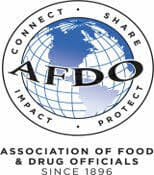Whether you use meal kits, restaurant delivery or grocery delivery, home food delivery gives us great food options! With so many more ways to bring food into our homes, our role in keeping great food SAFE has never been more important.
#PrepYourself

Be delivery smart!
Even as food delivery becomes more a part of your life, food safety remains important for you and your family!

Know your role!
As the way we receive food changes, the core food safety practices remain essential to protecting our health and the health of those we love.

Report issues!
Reporting a foodborne illness is a critical part of keeping food safe for everyone.
Food Safety Matters! If you think food poisoning is no big deal, click here to hear from real people about their experience and long-lasting consequences.

Be delivery smart!
Food delivery, which includes meal kits, restaurant delivery and grocery delivery, is on the rise! As food delivery becomes more a part of your life, food safety remains important for you and your family!
- Before ordering, take steps that will help ensure the food you want to enjoy stays safe.
- Ask questions. Understand the delivery company’s safety standards and how they respond if food is delivered at an unsafe temperature or appears to have been tampered with. Ask!
- Arrange for delivery when someone is at home so food can be refrigerated or stored quickly instead of being left outside until someone is at home.
- Find a safe space for delivery if no one will be at home when food arrives. This space should be cool, shaded and secure from pests and rodents. Include this location in your order.
- When your delivery driver hands off your food, they also hand you the responsibility of keeping your food safe.
- Examine the box and packaging. When you get your delivery, look for stickers on perishable foods that say “Keep Refrigerated” or “Keep Frozen.”
- Cook, Serve or Save. Enjoy your delivered prepared foods when it arrive. Cook raw foods, or or refrigerate or freeze foods as soon as possible. Bacteria can multiply rapidly if food is kept in the “danger zone” between 40 °F and 140 °F for more than two hours.

Know your role!
As the way we receive food changes, the core food safety practices remain essential to protecting our health and the health of those we love.
Follow three simple steps to fulfill your role!
- Wash counters. Cleaning surfaces with hot, soapy water can reduce the spread of harmful bacteria in your kitchen. You can’t see, taste or smell the bacteria that cause food poisoning. These germs can make you sick if ingested, and they spread through contact with surfaces, utensils, and food.
- Wash hands. Washing your hands is one of the most effective ways to prevent the spread of germs. Wash your hands with clean, running water and soap for at least 20 seconds before and after handling food and after using the bathroom, changing diapers and handling pets. If soap and water aren’t available, use an alcohol-based hand sanitizer that contains at least 60% alcohol.
- Cook, serve or save. When food is delivered, serve ready-to-eat foods immediately, cook raw foods you are ready to prepare now, and properly store foods you plan to eat later. Refrigerate or freeze any raw meat, poultry, eggs, cooked food or cut fresh fruits or vegetables that arrive in your grocery order within two hours. Food is safely cooked when it reaches a high enough internal temperature to kill the harmful bacteria that cause foodborne illness. Use a food thermometer to measure the internal temperature of cooked foods.
Did you know?
- In observational research conducted by the USDA more than 94% of people did not properly clean or sanitize counters before or after meal prep.
- Wash your cutting boards, dishes, utensils, and counter tops with hot soapy water after preparing each food item and before you go on to the next food.
- Consider using paper towels to clean up kitchen surfaces. If you use cloth towels wash them often in the hot cycle of your washing machine.
- After cleaning, you may sanitize surfaces as an extra precaution to kill germs. Use a solution of 1 tablespoon of unscented liquid chlorine bleach and 1 gallon of water. Apply to surfaces, and allow to stand for several minutes. Air dry or pat dry with fresh paper towels.
- Studies have shown that handwashing can prevent 1 in 3 diarrhea-related sicknesses and 1 in 5 respiratory infections. Yet, USDA observational data shows that before meal prep, only 5% of people wash hands correctly with soap.
- A food thermometer is the only way to measure the internal temperature of cooked meat, poultry and egg dishes, and ensure that the food is cooked to a safe internal temperature. Bring sauces, soups and gravy to a boil when reheating. Heat other leftovers thoroughly to 165 °F.

Report issues!
Reporting a foodborne illness is a critical part of keeping food safe for everyone.
- Notify the company if you suspect tampering or that perishable food was left out too long. Don’t eat the food, or even taste it to see if it is safe.
- If you or a family member experience symptoms of a serious foodborne illness, seek medical attention and contact your local health agency.
- The CDC public health gateway can help you locate your local health agency.
- Questions? Try these toll-free federal food safety hotlines. For meat, poultry, or pasteurized egg products, call the USDA Meat & Poultry Hotline at 1-888-MPHotline (1-888-674-6854). For all other food products, call FDA’s Food and Cosmetic Information Center at 1-888-SAFEFOOD (1-888-723-3366).
STORIES: Food Safety Matters!
One in 6 Americans gets sick from contaminated foods or beverages. Foodborne pathogens are traced back to 48 million illnesses, 128,000 hospitalizations, and 3,000 deaths each year.
The statistics paint an important picture, but if you’re thinking, “that will never happen to me,” think again. Food safety is everyone’s responsibility. The reality of food poisoning can have long lasting effects on your health. Hear from real people about how food poisoning changed their lives.
Rylee
As a nine-year-old, Rylee contracts an E. coli O157: H7 illness that attacks several of her vital organs and brings her close to death.
Prep Yourself Resources
If you’re interested in helping people navigate food safety in the food delivery environment, the Partnership for Food Safety Education is offering free Prep Yourself campaign resources to support your outreach efforts!
Brand Style and Usage Guide: This guide will provide you with guidance on how to use these resources.
Prep Yourself Logos: Use these logos as outlined in the attached brand style and usage guide.
Social Media Content: From post copy to images, this social media content can be integrated into your existing social media calendar.
Digital Ads: These digital ads are standard sizes so you can use them on your website or as part of your education efforts.
Downloadable Print Materials: Download these print-ready files for use with delivery items, at events or other in-person opportunities to connect with consumers.
Webinar: Watch the recording of the webinar presenting the new campaign and its resources.
Don’t miss future events and Prep Yourself campaign updates! Sign up for our newsletter here.
Thank you for your commitment to modernizing food safety education!





